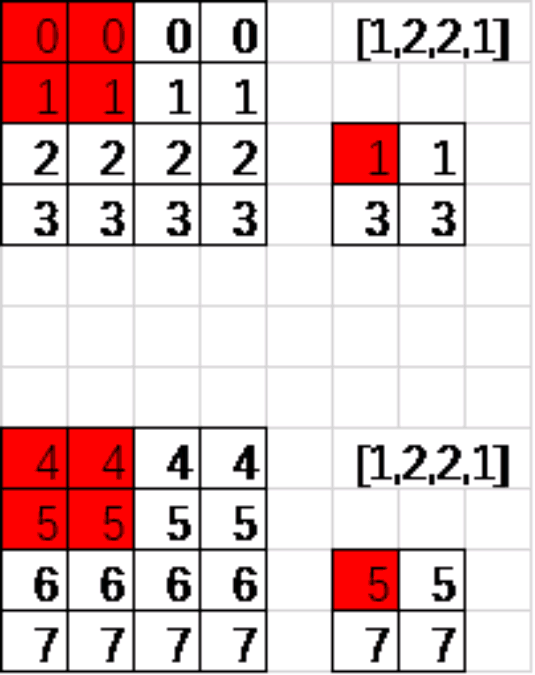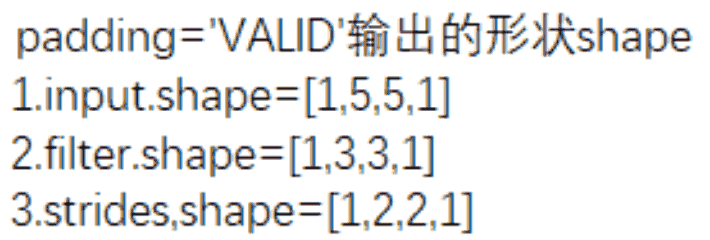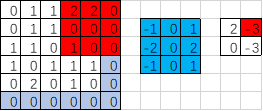CNN之池化层tf.nn.max_pool | tf.nn.avg_pool | tf.reduce_mean | padding的规则解释
摘要:池化层的主要目的是降维,通过滤波器映射区域内取最大值、平均值等操作。
均值池化:tf.nn.avg_pool(input,ksize,strides,padding)
最大池化:tf.nn.max_pool(input,ksize,strides,padding)
input:通常情况下是卷积层输出的featuremap,shape=[batch,height,width,channels]


假定这个矩阵就是卷积层输出的featuremap(2通道输出) 他的shape=[1,4,4,2]
ksize:池化窗口大小 shape=[batch,height,width,channels] 比如[1,2,2,1]
strides: 窗口在每一个维度上的移动步长 shape=[batch,stride,stride,channel] 比如[1,2,2,1]
padding:“VALID”不填充 “SAME”填充0
返回:tensor shape=[batch,height,width,channels]

上图是采用的最大池化,取红色框内最大的一个数。
import tensorflow as tf
feature_map = tf.constant([
[[0.0,4.0],[0.0,4.0],[0.0,4.0],[0.0,4.0]],
[[1.0,5.0],[1.0,5.0],[1.0,5.0],[1.0,5.0]],
[[2.0,6.0],[2.0,6.0],[2.0,6.0],[2.0,6.0]] ,
[[3.0,7.0],[3.0,7.0],[3.0,7.0],[3.0,7.0]]
])
feature_map = tf.reshape(feature_map,[1,4,4,2])##两通道featuremap输入 ##定义池化层
pooling = tf.nn.max_pool(feature_map,[1,2,2,1],[1,2,2,1],padding='VALID')##池化窗口2*2,高宽方向步长都为2,不填充
pooling1 = tf.nn.max_pool(feature_map,[1,2,2,1],[1,1,1,1],padding='VALID')##池化窗口2*2,高宽方向步长都为1,不填充
pooling2 = tf.nn.avg_pool(feature_map,[1,4,4,1],[1,1,1,1],padding='SAME')##池化窗口4*4,高宽方向步长都为1,填充
pooling3 = tf.nn.avg_pool(feature_map,[1,4,4,1],[1,4,4,1],padding='SAME')##池化窗口4*4,高宽方向步长都为4,填充
##转置变形(详细解释参考另一篇博文)
tran_reshape = tf.reshape(tf.transpose(feature_map),[-1,16])
pooling4 = tf.reduce_mean(tran_reshape,1) ###对行值求平均
with tf.Session() as sess:
print('featuremap:\n',sess.run(feature_map))
print('*'*30)
print('pooling:\n',sess.run(pooling))
print('*'*30)
print('pooling1:\n',sess.run(pooling1))
print('*'*30)
print('pooling2:\n',sess.run(pooling2))
print('*'*30)
print('pooling3:\n',sess.run(pooling3))
print('*'*30)
print('pooling4:\n',sess.run(pooling4))
'''
输出结果:
featuremap:
[[[[ 0. 4.]
[ 0. 4.]
[ 0. 4.]
[ 0. 4.]] [[ 1. 5.]
[ 1. 5.]
[ 1. 5.]
[ 1. 5.]] [[ 2. 6.]
[ 2. 6.]
[ 2. 6.]
[ 2. 6.]] [[ 3. 7.]
[ 3. 7.]
[ 3. 7.]
[ 3. 7.]]]]
******************************
pooling:
[[[[ 1. 5.]
[ 1. 5.]] [[ 3. 7.]
[ 3. 7.]]]]
******************************
pooling1:
[[[[ 1. 5.]
[ 1. 5.]
[ 1. 5.]] [[ 2. 6.]
[ 2. 6.]
[ 2. 6.]] [[ 3. 7.]
[ 3. 7.]
[ 3. 7.]]]]
******************************
pooling2:
[[[[ 1. 5. ]
[ 1. 5. ]
[ 1. 5. ]
[ 1. 5. ]] [[ 1.5 5.5]
[ 1.5 5.5]
[ 1.5 5.5]
[ 1.5 5.5]] [[ 2. 6. ]
[ 2. 6. ]
[ 2. 6. ]
[ 2. 6. ]] [[ 2.5 6.5]
[ 2.5 6.5]
[ 2.5 6.5]
[ 2.5 6.5]]]]
******************************
pooling3:
[[[[ 1.5 5.5]]]]
******************************
pooling4:
[ 1.5 5.5] '''
池化层常用函数及参数
现在我们对代码中的内容加以解释:
padding的规则
- padding=‘VALID’时,输出的宽度和高度的计算公式(下图gif为例)


输出宽度:output_width = (in_width-filter_width+1)/strides_width =(5-3+1)/2=1.5【向上取整=2】
输出高度:output_height = (in_height-filter_height+1)/strides_height =(5-3+1)/2=1.5【向上取整=2】
输出的形状[1,2,2,1]

import tensorflow as tf
image = [0,1.0,1,2,2,0,1,1,0,0,1,1,0,1,0,1,0,1,1,1,0,2,0,1,0]
input = tf.Variable(tf.constant(image,shape=[1,5,5,1])) ##1通道输入
fil1 = [-1.0,0,1,-2,0,2,-1,0,1]
filter = tf.Variable(tf.constant(fil1,shape=[3,3,1,1])) ##1个卷积核对应1个featuremap输出 op = tf.nn.conv2d(input,filter,strides=[1,2,2,1],padding='VALID') ##步长2,VALID不补0操作 init = tf.global_variables_initializer() with tf.Session() as sess:
sess.run(init)
# print('input:\n', sess.run(input))
# print('filter:\n', sess.run(filter))
print('op:\n',sess.run(op)) ##输出结果
'''
[[[[ 2.]
[-1.]] [[-1.]
[ 0.]]]]
'''
tensorflow中实现(步长2)
如果strides=[1,3,3,1]的情况又是如何呢?
输出宽度:output_width = (in_width-filter_width+1)/strides_width =(5-3+1)/3=1
输出高度:output_height = (in_height-filter_height+1)/strides_height =(5-3+1)/3=1
输出的形状[1,1,1,1],因此输出的结果只有一个

import tensorflow as tf
image = [0,1.0,1,2,2,0,1,1,0,0,1,1,0,1,0,1,0,1,1,1,0,2,0,1,0]
input = tf.Variable(tf.constant(image,shape=[1,5,5,1])) ##1通道输入
fil1 = [-1.0,0,1,-2,0,2,-1,0,1]
filter = tf.Variable(tf.constant(fil1,shape=[3,3,1,1])) ##1个卷积核对应1个featuremap输出 op = tf.nn.conv2d(input,filter,strides=[1,3,3,1],padding='VALID') ##步长2,VALID不补0操作 init = tf.global_variables_initializer() with tf.Session() as sess:
sess.run(init)
# print('input:\n', sess.run(input))
# print('filter:\n', sess.run(filter))
print('op:\n',sess.run(op)) ##输出结果
'''
op:
[[[[ 2.]]]]
'''
tensorflow中实现(步长3)
padding=‘SAME’时,输出的宽度和高度的计算公式(下图gif为例)

输出宽度:output_width = in_width/strides_width=5/2=2.5【向上取整3】
输出高度:output_height = in_height/strides_height=5/2=2.5【向上取整3】
则输出的形状:[1,3,3,1]
那么padding补0的规则又是如何的呢?【先确定输出形状,再计算补多少0】
pad_width = max((out_width-1)*strides_width+filter_width-in_width,0)=max((3-1)*2+3-5,0)=2
pad_height = max((out_height-1)*strides_height+filter_height-in_height,0)=max((3-1)*2+3-5,0)=2
pad_top = pad_height/2=1
pad_bottom = pad_height-pad_top=1
pad_left = pad_width/2=1
pad_right = pad_width-pad_left=1

import tensorflow as tf
image = [0,1.0,1,2,2,0,1,1,0,0,1,1,0,1,0,1,0,1,1,1,0,2,0,1,0]
input = tf.Variable(tf.constant(image,shape=[1,5,5,1])) ##1通道输入
fil1 = [-1.0,0,1,-2,0,2,-1,0,1]
filter = tf.Variable(tf.constant(fil1,shape=[3,3,1,1])) ##1个卷积核对应1个featuremap输出 op = tf.nn.conv2d(input,filter,strides=[1,2,2,1],padding='SAME') ##步长2,VALID不补0操作 init = tf.global_variables_initializer() with tf.Session() as sess:
sess.run(init)
# print('input:\n', sess.run(input))
# print('filter:\n', sess.run(filter))
print('op:\n',sess.run(op)) ##输出结果
'''
op:
[[[[ 3.]
[ 1.]
[-4.]] [[ 3.]
[ 0.]
[-3.]] [[ 4.]
[-1.]
[-3.]]]]
'''
SAME步长2
如果步长为3呢?补0的规则又如何?
输出宽度:output_width = in_width/strides_width=5/3=2
输出高度:output_height = in_height/strides_height=5/3=2
则输出的形状:[1,2,2,1]
那么padding补0的规则又是如何的呢?【先确定输出形状,再计算补多少0】
pad_width = max((out_width-1)*strides_width+filter_width-in_width,0)=max((2-1)*3+3-5,0)=1
pad_height = max((out_height-1)*strides_height+filter_height-in_height,0)=max((2-1)*3+3-5,0)=1
pad_top = pad_height/2=0【向下取整】
pad_bottom = pad_height-pad_top=1
pad_left = pad_width/2=0【向下取整】
pad_right = pad_width-pad_left=1

import tensorflow as tf
print(3/2)
image = [0,1.0,1,2,2,0,1,1,0,0,1,1,0,1,0,1,0,1,1,1,0,2,0,1,0]
input = tf.Variable(tf.constant(image,shape=[1,5,5,1])) ##1通道输入
fil1 = [-1.0,0,1,-2,0,2,-1,0,1]
filter = tf.Variable(tf.constant(fil1,shape=[3,3,1,1])) ##1个卷积核对应1个featuremap输出 op = tf.nn.conv2d(input,filter,strides=[1,3,3,1],padding='SAME') ##步长2,VALID不补0操作 init = tf.global_variables_initializer() with tf.Session() as sess:
sess.run(init)
# print('input:\n', sess.run(input))
# print('filter:\n', sess.run(filter))
print('op:\n',sess.run(op)) ##输出结果
'''
op:
[[[[ 2.]
[-3.]] [[ 0.]
[-3.]]]]
'''
SAME步长3
这里借用的卷积中的padding规则,在池化层中的padding规则与卷积中的padding规则一致
最新文章
- 寒冬之下,浩瀚智能开单收银打印扫描POS为何能在批发零售门店商场 车销行业 风靡!:进销存+打印扫描POS机
- 用css计算选中的复选框有几个
- 二模 (15)day1
- 如果jsp提交到action为空指针的话
- ASP.NET在删除掉数据库文件后报错处理
- XML中五个转义字符
- hdu 3572 Task Schedule(最大流)2010 ACM-ICPC Multi-University Training Contest(13)——Host by UESTC
- 制作SM2证书
- JQuery window、document、 body (转)
- Android视频录制
- css-布局1-基本属性
- 任务分配book
- 不同版本的mysql字符集的默认编写
- Python库:序列化和反序列化模块pickle介绍
- JAVA 8 函数式接口--Consumer
- django 模板语言
- Javascript高级编程学习笔记(4)—— JS中的数据类型(2)
- Android调试桥-Android Debug Birdge详解
- 【CF Gym100228】Graph of Inversions
- 解决 src/MD2.c:31:20: fatal error: Python.h: No such file or directory安装包错误
热门文章
- 问题 C: 序列交换
- 【数据库运维】数据库(server)的时区设置及世界主要地区的时区
- nodejs、npm、 typescript、angular-cli安装
- LeetCode Lect7 堆及其应用
- Gos: Armed Golang 💪
- Vue Login by Google
- 20191202IIS
- 奇葩问题:Invalid bound statement (not found): cn.zss.zsdemo.mapper.RoleMapper.selectByPrimaryKey
- Tcp客户端构建流程
- pg_config - 检索已安装版本的 PostgreSQL 的信息